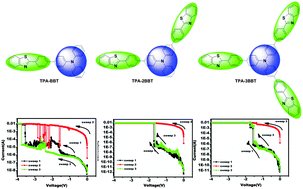Improving organic memory performance through mounting conjugated branches on a triphenylamine core†
Abstract
To study the influence of the number of branches mounted on molecular backbones on the thin-film morphology and performance of their memory devices, we successfully synthesized three conjugated small molecules containing triphenylamine and benzothiazole moieties (TPA-nBBT, n = 1, 2, 3) and studied their memory performances. Binary static random access memory (SRAM) characteristics could be achieved for the three compound-based devices with a sandwich-like configuration of ITO/molecule/Al. The device based on TPA-3BBT exhibited the best device performance with the lowest threshold voltage and the best thermal stability which is related to the temperature insensitive thin-film morphology and film crystallinity. Our results demonstrate that increasing the number of branches in D–A conjugated molecules to adjust film morphology and intermolecular accumulation may be an effective strategy to improve the stability and performance of devices.


 Please wait while we load your content...
Please wait while we load your content...